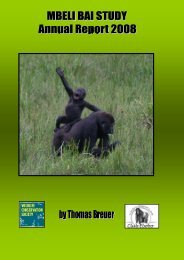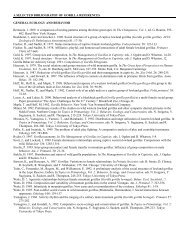First Prosimian Husbandry Workshop 2009 - Cleveland Metroparks ...
First Prosimian Husbandry Workshop 2009 - Cleveland Metroparks ...
First Prosimian Husbandry Workshop 2009 - Cleveland Metroparks ...
Create successful ePaper yourself
Turn your PDF publications into a flip-book with our unique Google optimized e-Paper software.
Session 7: <strong>Prosimian</strong> Mixed Species Exhibits:<br />
(Moderator Monica Mogilewsky, Lemur Conservation Foundation)<br />
Topics<br />
Introduction to the session<br />
Goals of Mixed Species Exhibits<br />
Advantages of Mixed Species Exhibits<br />
Challenges of Mixed Species Exhibits<br />
Solutions to Mixed Species Challenges<br />
Close<br />
Moderator (Monica Mogilwesky): How many institutions have mixed-species lemur exhibits? (Lots of<br />
raised hands.)<br />
Moderator (Monica Mogilewsky): What species are people putting together:<br />
Cats of the World: brown and ring-tailed<br />
Potter Park: red ruffed and mongoose<br />
Capron Park Zoo: black and white ruffed and coronotus<br />
Advantages of Mixed Species Groups:<br />
• (Desiree Haneman): to provide companionship for social outcasts<br />
• (Jacqueline Broder): because director thinks mongoose lemurs are boring; to make exhibits<br />
more interesting.<br />
• (Helena Fitch Snyder): for nocturnals, to make exhibits more interesting, to maximize use of<br />
space<br />
• To make animals more active<br />
• (Kris Arnold): to educate the public that there are many types of lemurs, not just ring-tailed and<br />
ruffed lemurs. They have a gorgeous red-fronted brown lemur. Provides educational<br />
opportunities with camps.<br />
• (Sarah Armstrong): but generally ring-tailed lemurs are the most successful in mixed-species<br />
groups.<br />
Disadvantages of Mixed-Species Groups:<br />
• Ring tailed and ruffed just aren’t getting along<br />
• (Laura Suski): E. flavifrons will not tolerate other animals; Vaercia won’t tolerate other<br />
animals either<br />
• Moderator (Monica Mogilewsky): complexity of managing groups is increased; have multiple<br />
group dynamics to regulate.<br />
• (Karen Weisenseel): know that species can be aggressive. Cheirogaleus broke the neck of<br />
galago in one exhibit she worked with.<br />
• (Mike Dulaney): have to watch diets for nocturnals housed with diurnals (and in general)<br />
• Moderator (Monica Mogilewsky): diet issues are common, particularly with mongoose lemurs<br />
which will tend to overeat.<br />
• (Laura Suski): Diet issues are common, they feed different chows to different species so it may<br />
be better to house species together that have similar diets.<br />
• Management pushes for mixed-species exhibits.<br />
• (Helena Fitch Snyder): disease issues. Lorises housed with provost’s squirrels have died from<br />
infectious disease contracted from squirrels; lorises carry a parasite that is fatal to callitrichids.<br />
• (Tad Schoffner): we had a prevost’s squirrel give pasturela to a loris.<br />
• Moderator (Monica Mogilewsky): we may not know disease risks until too late.<br />
35




